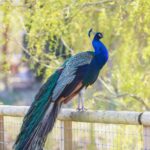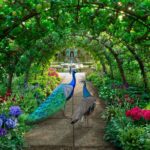There are loads of wild peacocks in Washington State, you can find them in just about every major city.
I’ve seen accounts of peacocks being spotted in Seattle, Spokane, Tacoma, Vancouver, and Bellevue, just to mention a few places!
But how did such an exotic bird that is not native to the US become wild in Washington State?
Here’s everything you need to know about these magnificent- but often annoying - birds:
Table of Contents
Why Are There Wild Peacocks in Washington State?
Peacocks, which are male peafowl, are more commonly seen at amusement parks or roaming the grounds of large properties than they are living ‘wild’.
They’re not native to the US, but the numbers of wild peafowl have been increasing across the US for decades.
It’s generally believed that peacocks or peahens escaped from being kept as pets or tourist attractions, and started populating in the wild.
Peacocks have been kept as pets for decades, and they’re very adept at surviving off the land, so it’s no surprise they’ve been able to increase in numbers living wild.
Being omnivores, they’re able to eat just about anything edible they can find, and peacocks are also invasive birds and will roam where they need to.
They’re not great at flying, only being able to manage a mile or so at a time. But peacocks will cover some distance to find areas where they feel safe and have everything they need.
Peacocks are clearly not designed to live in close proximity to humans though, and this is when problems really arise.
Related - More on wild peafowl in Florida, Michigan, and Texas.
Are Peacocks Invasive in Washington State?
Peacocks are an invasive species, generally speaking. If you’ve come across them in Washington State I’m sure you’ll agree with this statement.
Peafowls tend to go about their business and aren’t too bothered by humans. If they see something they want to eat or investigate, they’re usually bold enough to take a closer look.
When they’re living in built-up areas, peacocks will help themselves to anything edible in yards and gardens, and that’s part of the problem.
It can be hard to read a peacock’s body language, too. When they’re spreading their tail feathers, it can be a sign of courtship - as well as a warning sign that they feel threatened.
The best advice is to not approach peafowl. Admire them from afar, and if they’re on your property shoo them away from a distance!
Are Peacocks Protected in Washington State
At the time of writing this, I couldn’t find evidence in the Washington State Legislature that peacocks were protected by state laws.
That said, it’s not clear - at least not to me - what you’re lawfully allowed to do if peacocks are causing damage to your property, annoying you in any way, or if you just want to hunt them.
I did read some comments in a Washington hunting forum, and there were also mixed opinions there about how peafowl are classified, too.
I wouldn’t go ahead and take matters into your own hands without at least contacting your local office and asking what the laws are where you live.
In some states, peafowl are protected under animal cruelty laws and there are some hefty fines and other punishments for harming them.
It’s better to be safe than sorry!
What Type of Peacocks Are in Washington State?
Generally speaking, there are three main species of peafowl, these are:
- Indian blue peafowl
- Green peafowl which is also called the Indonesian peafowl, and
- Congo peafowl which is also called the African peafowl
The Green peafowl is native to Southeast Asia and the Indonesian island of Java in particular.
This species is actually listed as being endangered and is not commonly seen around the world.
The Congo peafowl is also endangered, the Association of Zoos and Aquariums have set up programs to help preserve and maintain their numbers.
It’s the Indian blue peafowl that is commonly seen across the US and will be the type of peafowl you see if you spot them roaming around.
The Indian blue peacock is the one that I’m sure you’ve seen in pictures before. They have the iconic bright blue and green feathers with distinctive ‘eye’ patterns.
There are other colors and variations of peacocks, so don’t be surprised to see some interesting colors (all-white peafowl are spectacular) in zoos and kept privately.
In Summary
Some people love having them around, and some people hate it - either way, there are a lot of wild peacocks in Washington state and the numbers are only increasing.
If you enjoy having peacocks in your neighborhood, be sure to admire their tail displays from afar.
If you’re on the side that finds peafowl invasive and annoying, contact your local office and follow the correct steps to do something about them.
Resources
Image credits - Image by confused_me from Pixabay




